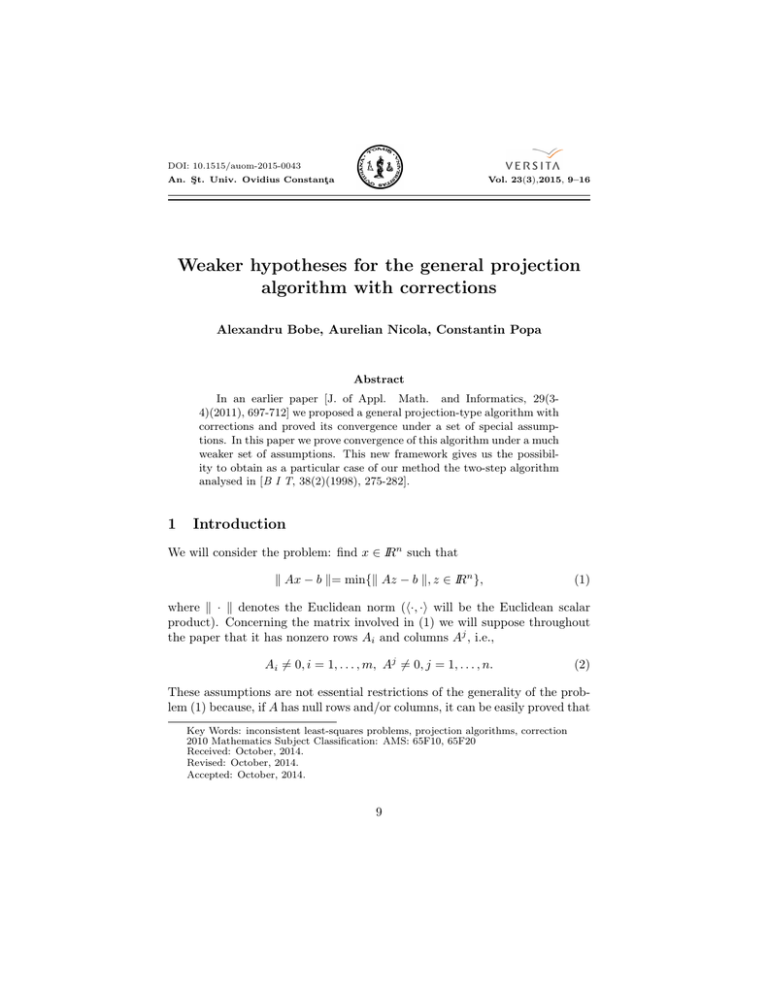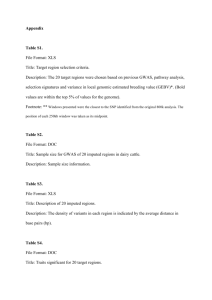Weaker hypotheses for the general projection algorithm with corrections
advertisement

DOI: 10.1515/auom-2015-0043
An. Şt. Univ. Ovidius Constanţa
Vol. 23(3),2015, 9–16
Weaker hypotheses for the general projection
algorithm with corrections
Alexandru Bobe, Aurelian Nicola, Constantin Popa
Abstract
In an earlier paper [J. of Appl. Math. and Informatics, 29(34)(2011), 697-712] we proposed a general projection-type algorithm with
corrections and proved its convergence under a set of special assumptions. In this paper we prove convergence of this algorithm under a much
weaker set of assumptions. This new framework gives us the possibility to obtain as a particular case of our method the two-step algorithm
analysed in [B I T, 38(2)(1998), 275-282].
1
Introduction
We will consider the problem: find x ∈ IRn such that
k Ax − b k= min{k Az − b k, z ∈ IRn },
(1)
where k · k denotes the Euclidean norm (h·, ·i will be the Euclidean scalar
product). Concerning the matrix involved in (1) we will suppose throughout
the paper that it has nonzero rows Ai and columns Aj , i.e.,
Ai 6= 0, i = 1, . . . , m, Aj 6= 0, j = 1, . . . , n.
(2)
These assumptions are not essential restrictions of the generality of the problem (1) because, if A has null rows and/or columns, it can be easily proved that
Key Words: inconsistent least-squares problems, projection algorithms, correction
2010 Mathematics Subject Classification: AMS: 65F10, 65F20
Received: October, 2014.
Revised: October, 2014.
Accepted: October, 2014.
9
Weaker hypotheses for the general projection algorithm with corrections
10
they can be eliminated without affecting its set of classical or least squares solutions. We first introduce some notations: the spectrum and spectral radius
of a square matrix will be denoted by σ(B) and ρ(B), respectively. By AT ,
N(A), R(A) we will denote the transpose, null space and range of A. PS (x)
will be the orthogonal (Euclidean) projection onto a vector subspace S of some
IRq . S(A; b), LSS(A; b), xLS will stand for the set of classical and least squares
solution of (1), respectively, and the (unique) minimal norm solution. In the
consistent case for (1) we have S(A; b) = LSS(A; b). In the general case the
following properties are known (see [5], Chapter 1)
xLS ⊥ N(A), b = bA + b∗A , with bA = PR(A) (b), b∗A = PN(AT ) (b),
(3)
LSS(A; b) = xLS + N(A) and x ∈ LSS(A; b) ⇔ Ax = bA ,
(4)
S(A; b) = xLS + N(A) and x ∈ S(A; b) ⇔ Ax = b.
(5)
Let Q : n × n and R : n × m be real matrices satisfying the (main) assumptions
I − Q = RA,
(6)
if Q̃ = QPR(AT ) , then k Q̃ k < 1,
(7)
and
where k Q̃ k denotes the spectral norm of the matrix Q̃. In the paper [4] we
proposed the following algorithm (a standard example of such an algorithm is
Kaczmarz’s projection method; see Algorithm 5.4.3 in [1]).
Algorithm General Projections with Corrections.
Initialization: x0 ∈ IRn is arbitrary.
Iterative step:
xk+1 = Qxk + Rb + v k ,
(8)
where
v k ∈ R(AT ), ∀k ≥ 0.
(9)
We introduced in [4] the additional assumptions:
∀y ∈ IRm , Ry ∈ R(AT ),
(10)
εk := v k + Rb∗A ,
(11)
and, for εk defined by
we assumed that there exist constants c > 0 and δ ∈ [0, 1) such that
k εk k≤ cδ k , ∀k ≥ 0.
Then, the following result was proved in [4].
(12)
Weaker hypotheses for the general projection algorithm with corrections
11
Theorem 1. Under the assumptions (6) – (7) and (9) – (12), for any sequence
(xk )k≥0 generated by the algorithm (8) we have
PN(A) (xk ) = PN(A) (x0 ), ∀k ≥ 0
(13)
lim xk = PN(A) (x0 ) + xLS ∈ LSS(A; b).
(14)
and
k→∞
In this paper we will introduce a new set of assumptions weaker than (7)
and (12) and we will prove that the algorithm (8) has the same convergence
properties. Moreover, we will show that the two step algorithm presented by
Elfving in [2] fits into the above mentioned more general hypotheses.
2
The new set of weaker assumptions
We will keep the assumptions (6), (10) and (9), but replace (7) with
if Q̃ = QPR(AT ) , then ρ(Q̃) < 1.
(15)
lim εk = 0.
(16)
and replace (12) with
k→∞
By a direct application of (6) and (10) we obtain
if x ∈ N(A) then Qx = x ∈ N(A),
(17)
if x ∈ R(AT ) then Qx = x − RAx ∈ R(AT ).
(18)
Moreover, the equalities (13) hold as in Lemma 1 of [4].
We can now prove the main result of our paper.
Theorem 2. Under the hypotheses,
I − Q = RA,
if Q̃ = QPR(AT ) , then ρ(Q̃) < 1,
∀y ∈ IRm , Ry ∈ R(AT ),
v k ∈ R(AT ), ∀k ≥ 0,
lim εk = 0,
k→∞
any sequence (xk )k≥0 generated by the algorithm (8) converges and (14) holds.
12
Weaker hypotheses for the general projection algorithm with corrections
Proof. According to (13) we can define the error vector of the iteration (8)
as
ek = xk − (PN(A) (x0 ) + xLS ).
(19)
Moreover, from (15) it follows that (I − Q̃) is invertible and (see, e.g., [3])
X
(I − Q̃)−1 = I + Q̃ + Q̃2 + · · · =
Q̃j .
(20)
j≥0
Then, as in [4] we obtain the equality
ek+1 = Q̃ek + εk , ∀k ≥ 0,
(21)
from which we get
ek = Q̃k e0 +
k−1
X
Q̃k−1−i εi , ∀k ≥ 1.
(22)
i=0
From (15) (see [3], Lemma 5.6.10) there exist a matrix norm (depending on
Q̃) k · k∗ such that
k Q̃ k∗ < 1.
(23)
Let k · k∗ be a vector norm compatible with the above matrix norm, then
k Q̃x k∗ ≤ k Q̃ k∗ k x k∗ , ∀x ∈ IRn .
(24)
But, from (16) we obtain that limk→∞ k εk k∗ = 0, thus (see also (23)) if > 0
is arbitrary fixed there exist an M > 0 and an integer k1 ≥ 1 such that
k εk k∗ ≤ M, ∀k ≥ 1
(25)
k Q̃ kk∗ ≤ , k εk k∗ < , ∀k ≥ k1 .
(26)
and
Then we define k ≥ 1 by
k = 2k1 + 1
(27)
and consider k = k + µ, with an arbitrary integer µ ≥ 0. Now, we first take
norms, use (26) and split the sum in (22) as
k ek k∗ ≤ k Q̃ kk∗ k e0 k∗ +
k−1
X
k Q̃ kk−1−i
k εi k∗
∗
i=0
1
0
≤ k e k∗ +
k
X
i=0
k Q̃ k∗k−1−i k εi k∗ +
k−1
X
i=k1 +1
k Q̃ kk−1−i
k εi k ∗ .
∗
(28)
13
Weaker hypotheses for the general projection algorithm with corrections
For the first sum in (28), from (25) and (26) we get
1
k
X
k Q̃ kk−1−i
k εi k∗
∗
i=0
k1
≤ M
X
k−1−k1
k Q̃ k∗k−1−i = M k Q̃ kk−1
+ · · · + k Q̃ k∗
∗
i=0
= M k Q̃
k−1−k1
k∗
k Q̃
k1
k∗
+ · · · + 1 = M k Q̃
k1 +µ
≤ M k Q̃ k∗
k1 +µ
k∗ k1 +1
1− k Q̃ k∗
1− k Q̃ k∗
M
1
<
.
1− k Q̃ k∗
1− k Q̃ k∗
(29)
For the second sum in (28), from the above formula for k, (27) and (26) we
get
k−1
X
1
k1 +µ−1
k Q̃ k∗k−1−i k εi k∗ =k Q̃ k∗
k εk +1 k∗
i=k1 +1
k1 +µ−2
+ k Q̃ k∗
1
1
1
k εk +2 k∗ + · · · + k Q̃ k∗ k εk +µ−1 k∗ + k εk +µ k∗
1
k1 +µ−1
≤k εk +1 k∗ k Q̃ k∗
+··· + 1
k1 +µ
k1 +1
=k ε
1− k Q̃ k∗
k∗
1− k Q̃ k∗
< 1
.
1− k Q̃ k∗
(30)
From (26) and (28) – (30) we conclude that, for an arbitrary > 0, there exist
an integer k ≥ 1 (see also (27)), such that for any k ≥ k we have
k ek k∗ ≤ k e0 k∗ +
k−1
X
k Q̃ k∗k−1−i k εi k∗
i=0
M
1
M +1
0
≤ k e k∗ +
+
= k e k∗ +
1− k Q̃ k∗
1− k Q̃ k∗
1− k Q̃ k∗
0
(31)
from which (14) follows and the proof is complete.
Corollary 1. Suppose that (6), (15), and (16) hold, and that
xk ∈ R(AT ), ∀k ≥ 0.
(32)
Then, any sequence (xk )k≥0 generated by the algorithm (8) converges and
lim xk = xLS .
k→∞
(33)
Weaker hypotheses for the general projection algorithm with corrections
14
Proof. We define the error vector ek by
ek := xk − xLS , ∀k ≥ 0.
(34)
Because of (18) and the fact that xLS ∈ R(AT ) we get
QxLS = Q̃xLS ,
(35)
and
(I − Q̃)xLS = xLS − QPR(AT ) (xLS )
= xLS − QxLS = (I − Q)xLS = RAxLS = RbA ,
thus,
RbA = (I − Q̃)xLS = (I − Q)xLS .
(36)
Consequently, by using (34), (8), (32) and (36) we successively get , ∀k ≥ 0
ek+1 = xk+1 − xLS = Q̃xk + Rb + v k − xLS
= Q̃xk + Rb + v k − (Q̃xLS + RbA ) = Q̃(xk − xLS ) + v k + Rb∗A = Q̃ek + εk . (37)
Then, as in the proof of Theorem 2 we obtain (22) for ek from (34) and then
(33), because for x0 ∈ R(AT ) we have PN(A) (x0 ) = 0. This completes the
proof.
Next we show that the two steps algorithm of Elfving [2] is a special case of
our algorithm.
Algorithm Elfving (ELF).
Initialization:
x0 ∈ R(AT ), y 0 = b − Az 0 , for some z 0 ∈ IRn .
(38)
y k+1 = (I − AΓ)y k ,
(39)
xk+1 = Qxk + R(b − y k+1 ).
(40)
Iterative step:
The matrices Q : n × n, R : n × m, Γ : m × n satisfy
Q + RA = I,
(41)
for w ∈ R(A), z = Qz + Rw if and only if Az = w,
(42)
ρ((I − AΓ)PR(A) ) < 1,
(43)
ρ(QPR(AT ) ) < 1,
(44)
and
z ∈ N(AT ) =⇒ Γz = 0,
(45)
u ∈ R(A) =⇒ Ru ∈ R(A ).
(46)
T
Weaker hypotheses for the general projection algorithm with corrections
15
Proposition 1. (i) The algorithm (ELF) is identical with algorithm (8), with
the corrections v k defined by
v k := −Ry k+1 .
(47)
(ii) The assumptions (6), (15), (16) and (32) are satisfied.
Proof. The assumptions (6) and (15) are identical with (41) and (44),
respectively.
To show that assumption (32) holds we argue by mathematical induction, as
in the proof of Proposition 3 in [4].
Assumption (16) holds because, from (47), and again as in the proof cited
before, we get
k+1
(bA ).
v k + Rb∗A = −Ry k+1 + Rb∗A = −R (I − AΓ)PR(A)
According to the hypothesis (43) and Theorem 1, from Chapter 1 in [5], the
matrix (I − AΓ)PR(A) is convergent, i.e. limk→∞ ((I − AΓ)PR(A) )k = 0, from
which we get (16) and the proof is complete.
Acknowledgements. The authors wish to thank to the anonymous referees
for their valuable comments that improved the initial version of the paper.
References
[1] Censor Y., S. A. Zenios Parallel Optimization: Theory, Algorithms and
Applications, Oxford Univ. Press, New York, 1997.
[2] Elfving T., A stationary iterative pseudoinverse algorithm, B I T, 38(2)
(1998), 275-282.
[3] Horn R. A., Johnson C. R., Matrix Analysis, Cambridge University Press,
New York, 1990.
[4] Nicola A., Popa C. and Rüde U., Projection algorithms with correction,
Journal of Applied Mathematics and Informatics, 29 (3-4) (2011), 697712.
[5] Popa C., Projection Algorithms - Classical Results and Developments.
Applications to Image Reconstruction, Lambert Academic Publishing AV Akademikerverlag GmbH & Co. KG, Saarbrücken, Germany, 2012.
Weaker hypotheses for the general projection algorithm with corrections
Alexandru Bobe,
Ovidius University of Constanta,
Faculty of Mathematics and Informatics,
Blvd. Mamaia 124, 900527, Constanta, Romania
Email: alexb@univ-ovidius.ro
Aurelian Nicola,
Ovidius University of Constanta,
Faculty of Mathematics and Informatics,
Blvd. Mamaia 124, 900527, Constanta, Romania
Email: anicola@univ-ovidius.ro, aurelian.nicola@gmail.com
Constantin Popa,
Ovidius University of Constanta,
Faculty of Mathematics and Informatics,
Blvd. Mamaia 124, 900527, Constanta, Romania
Email: cpopa@univ-ovidius.ro, cpopa1956@gmail.com
16



